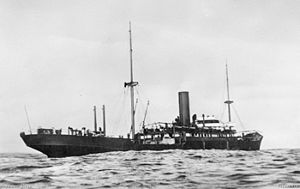SMS Wolf (auxiliary cruiser)

Hilfskreuzer SMS Wolf
|
|
| History | |
|---|---|
| Name: |
|
| Owner: |
|
| Operator: | |
| Port of registry: |
|
| Builder: | Flensburger Schiffbau Gesellschaft |
| Launched: | 8 March 1913 |
| Commissioned: | 16 May 1916 |
| Out of service: | 1918 |
| Fate: | Scrapped 1931 |
| General characteristics | |
| Displacement: | 11,200 tons (5,809 GRT) |
| Length: | 135 m (442 ft 11 in) |
| Beam: | 17.10 m (56 ft 1 in) |
| Draught: | 7.90 m (25 ft 11 in) |
| Propulsion: | 1 shaft VTE steam engine, 3 boilers |
| Speed: | 11 knots (20 km/h; 13 mph) |
| Complement: | 348 |
| Armament: |
|
| Aircraft carried: | 1 Friedrichshafen FF.33 seaplane |
SMS Wolf (formerly the Hansa freighter Wachtfels) was an armed merchant raider or auxiliary cruiser of the Imperial German Navy in World War I. She was the fourth ship of the Imperial Navy bearing this name (and is therefore often referred to in Germany as Wolf IV), following two gunboats and another auxiliary cruiser that was decommissioned without seeing action.
As a commerce raider, the Wolf was equipped with six 15 cm (5.9 in) guns, three 5.2 cm (2.0 in) guns and several smaller caliber weapons as well as four torpedo tubes. She also carried over 450 mines to be dropped outside enemy ports; she laid one minefield off Australia's southern coast which claimed several ships. Her commander was Fregattenkapitän (Commander) Karl August Nerger who was in charge until her return to Kiel, Germany in February 1918.
The Wolf had not been designed for speed and her top speed was a mere 11 knots (20 km/h). Her advantages included deception (fake funnel and masts which could be erected or lowered to change her appearance), false sides which kept her weapons hidden until the last possible moment, and a range of over 32,000 nmi (59,000 km) thanks to a coal bunker capacity of 8,000 tons (assuming a cruise speed of 8 knots, burning 35 tons of coal daily).
On 30 November 1916 the Wolf left her home port of Kiel with a crew of 348 men. Escorted by the SM U-66 from Skagerrak to the North Atlantic, she passed north of Scotland and turned south going around the Cape of Good Hope, where she laid some of her mines, into the Indian Ocean. She dropped mines at the harbors of Colombo and Bombay, then entered the waters of South Asia, Australia and New Zealand.
...
Wikipedia
